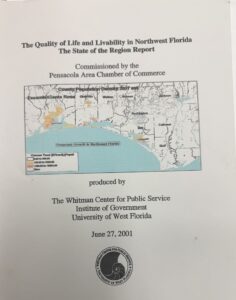
 In 2001, the Pensacola Area Chamber of Commerce asked the UWF Whitman Center for Public Service to produce a Quality of Life and Livability study of Northwest Florida. They surveyed 600 Escambia and Santa Rosa residents about their perceptions of quality of life.
In 2001, the Pensacola Area Chamber of Commerce asked the UWF Whitman Center for Public Service to produce a Quality of Life and Livability study of Northwest Florida. They surveyed 600 Escambia and Santa Rosa residents about their perceptions of quality of life.
The study examined three factors of livability: productivity, place, and people. It used nine variables and 39 indicators of livability to compile a livable county index, LCI.
The report was not perfect. However, this was a starting point for measuring and monitoring changes in quality of life conditions in the future. Wayne Teasley, the Whitman Center for Public Service’s executive director, hoped this would be the beginning of many more reports.
Unfortunately, the Chamber didn’t follow up. The community and Chamber had to deal with the impact of the 9/11 attack, the indictment of four commissioners, the hiring of a new Chamber president/CEO and Hurricane Ivan.
- The Quality of Life survey would not be conducted again – until the Studer Community Institute began doing it in 2008.
But what did the first report say?
COMMUNITY ASSETS
- Police protection, fire protection, medical services and trash pickup are viewed as very positive assets in both counties.
- Both communities view traffic, childcare, youth activities, social services, and senior activities as negative assets.
- Parks and recreation were borderline services in both counties. Public schools were rated as a negative asset in Escambia County and a very positive asset in Santa Rosa County. Culture and art activities were slightly positive in Escambia County but slightly negative in Santa Rosa County.
EDUCATION
About two-thirds of the sample are satisfied with the education system preparing people for jobs. They also believe education will improve in the next five years.
ECONOMY AND JOBS
- About one-third of the sample thought good jobs were readily available in the region.
- 38% and 48% of Escambia and Santa Rosa residents, respectively, said they were better off financially this year than last.
- A minority, 42% of Escambia residents, thought the economy could be better, while a slight majority, 51.5% of Santa Rosa residents, were economically optimistic.
- Nearly 30% of households in both counties had one or more people seeking a job or looking for a better job.
- More Escambia residents wanted an increase in high-tech jobs: 67.6%, while Santa Rosa residents expressed interest in more manufacturing jobs: 55.5%
TRAFFIC AND CONGESTION
Over 80% of the sample believed roads and traffic would worsen over the next five years. This was the biggest concern in the survey.
CRIME AND SAFETY
- The perception of serious crime was almost twice as great. 21.2% to 11% in Escambia compared to Santa Rosa.
- Similarly, the perception of their neighborhood is unsafe to walk alone at night, which is nearly twice as great in Escambia, 27.1% to 15.5%.
- Finally, the perception that crime would worsen was slightly higher in Escambia than in Santa Rosa: 32% to 23.5%.
- The principal difference in the respondents’ perceptions of crime in the two counties was in the non-white neighborhoods of Escambia County.
POPULATION GROWTH
Although slightly higher in Santa Rosa, only a small percentage, 13%, supports substantial or high rates of population growth. Over one-third of the sample, 35.7%, wanted no growth at all. The percentage was greater in Escambia: 39.5%.
ENVIRONMENT
- A minority of Escambians, 46.5%, think surface water quality is good. In Santa Rosa, it’s 60.5%.
- The majority of residents in both counties, 62.3% in Escambia and 71% in Santa Rosa, rate the air quality as good.
- However, a large percentage—46.1% in Escambia and 43% in Santa Rosa—think environmental quality in their respective counties will worsen over the next five years.
SOCIAL CONDITIONS AND RACISM
- Racism was viewed as more serious in Escambia than in Santa Rosa: 56.8% to 37.5%.
- Racial victimization was nearly twice as great in Escambia: 16.8% to 9%.
- Equality of opportunity was seen as higher in Santa Rosa: 54% to 70.5%.
COMMUNITY LEADERSHIP
The quality of community leadership was viewed much more positively—as good and very good—in Santa Rosa County than in Escambia. 57% in Santa Rosa, and 41.5% in Escambia
INDICATORS IN FIVE-COUNTY REGION
PRODUCTIVITY
Economy: Okaloosa was first, Santa Rosa third, and Escambia fourth.
K- 12 education: Okaloosa is first. Escambia is second. Santa Rosa is third.
Higher education: Escambia is first, which is no surprise. Bay is second, probably because of FSU, and the third is Okaloosa.
PLACE
Natural environment: Santa Rosa’s first, Escambia’s last, Okaloosa just ahead of Escambia
Traffic: Santa Rosa’s first, Escambia last, and Okaloosa fourth.
Recreation: Bay and Okaloosa are ahead of Escambia, which is well ahead of Santa Rosa. Note that none of the northwest Florida counties are up to the statewide average.
PEOPLE
Care of children: Okaloosa is first, Santa Rosa second, Escambia last
Healthcare: Escambia is first, Okaloosa is second, and Santa Rosa is third.
Public safety: Santa Rosa is first, Okaloosa second. Escambia is next to last compared to Florida’s average.
OVERALL LIVABILITY
Okaloosa is first because of the economy, K-12, education, recreation, and the care of children. Santa Rosa is fourth because of the environment, traffic, safety, and care of children. Escambia is fourth.
LESSONS LEARNED
The broad lessons garnered from the report using the LCI model indicate that various factors determine quality of life. Under varying scenarios, Escambia and Santa Rosa counties are rated as the most livable because each has different strengths. This may lend credibility to EscaRosa as a necessarily connected geographic region. Finally, the survey showed that most residents are satisfied with their respective counties.
Improving one livability factor may often come at the expense of another. For example, we saw that size and economic development may come at the expense of pollution, traffic, and crime.
Finally, while the researchers avoided causal analysis in this report, it’s evident that some factors greatly affect other variables that can be linked in sequential, if not causal, order. For example, poverty is related to crime, cancer deaths, and low economic achievement. Educational achievement is related to job growth and effective solutions for quality of life and livability. Issues should be directed at the causes, not the symptoms.
Photo Licensed under the Unsplash+ License



